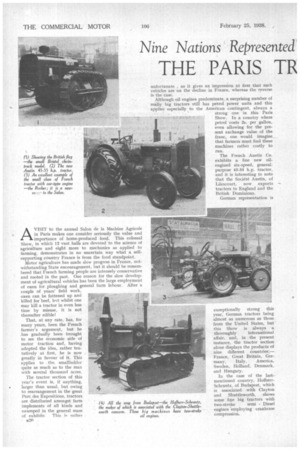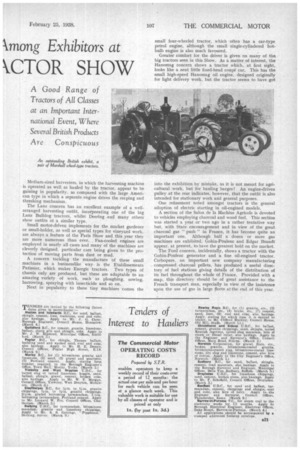Nine Nations Represented
Page 58

Page 59

If you've noticed an error in this article please click here to report it so we can fix it.
krnong Exhibitors at
THE PARIS TB
\ETOR SHOW A Good Range of Tractors of All Classes at an Important International Event, Where Several British Products Are Conspicuous AVISIT to the annual Salon de la Machine Agricole in Paris makes one consider seriously the value and importance of home-produced food. This colossal Show, in which 12 vast halls are devoted to the science of agriculture and eight more to mechanics as applied to farming, demonstrates in no uncertain way what a selfsupporting cciuntry France is from the food standpoint.
Motor agriculture has made slow progress in France, notwithstanding State encouragement, but it should be remembered that French farming people are intensely conservative and rooted in the past. One reason for the slow development of agricultural vehicles has been the large employment of oxen for ploughing and general farm labour. After a couple of years field work, oxen can be fattened up and killed for beef, b.it whilst one may kill a tractor in even less time by misuse, it is not thereafter edible!
That, at any rate, has, for many years, been the French farmer's argument, but he has gradually been brought to see the economic side of motor traction and, having adopted the idea, rather tentatively at first, he is now greatly in favour of it. This applies to the smallholder quite as much as to the man with several thousand acres.
The tractor section of this year's event is, if anything, • larger than usual, but owing to rearrangement in the great Parc des Expositions, tractors are distributed amongst farm implements of all kinds and swamped in the general mass of exhibits This is rather • n2A
unfortunate , as it gives an impression at first that such vehicles are on the decline in France, whereas the reverse is the case.
Although oil engines predominate, a surprising number of really big tractors still has petrol power units and this applies especially to the American contingent, always a strong one in this Paris Show. In a country where petrol costs 2s. per gallon, even allowing for the present exchange value of the franc, one would imagine that farmers must find these machines rather costly to run.
The French Austin Co. exhibits a fine new oilengined six-speed, generalpurpose 45-55 h.p. tractor, -and it is interesting to note that the Societe Austin, of Liancourt, now exports tractors to England and the British Dominions.
German representation is exceptionally strong this year, German tractors being almost as numerous as those from the United States, but this Show is always a thoroughly international affair, and, in the present instance, the tractor section alone displays the products of nine different countries:— France, Great Britain, Ger many, Italy, America, Sweden, Holland, Denmark, and Hungary.
In the case of the lastmentioned country, HofherrSchrantz, of Budapest, which is associated with Clayton and Shuttleworth, shows some fine big tractors with two-stroke semi Diesel engines 'employing crankcase compression.
Medium-sized harvesters, in which the harvesting machine is operated as well as hauled by the tractor, appear to be gaining in popularity, as compared with the large American type in which a separate engine drives the reaping and threshing mechanism.
The Lanz concern has an excellent example of a wellarranged harvesting outfit, incorporating one of the big Lanz Bulldog tractors, whilst Deering and many others show outfits of a similar type. Small motor-driven implements for the market gardener or small-holder, as well as special types for vineyard work, are always a feature of the Paris Show and this year they are more numerous than ever. Fan-cooled engines are employed in nearly all cases and many of the machines are cleverly designed, particular care being given to the protection of moving parts from dust or mud.
A concern tackling the manufacture of these small machines in a businesslike way is the Etablissements Patissier, which makes Energic tractors. Two types of chassis only are produced, but these are adaptable to an amazing variety of work, such as ploughing, sowing, harrowing, spraying with insecticide and so on.
Next in popularity to these tiny machines comes the small four-wheeled tractor, which often has a car-type petrol engine, although the small single-cylindered hotbulb engine is also much favoured.
Greater comfort for the driver is given on many of the big tractors seen in this Show. As a matter of interest, the Hanomag concern shows a tractor which, at first sight, looks like a neat little fixed-head coupe car. This has the small high-speed Hanomag oil engine, designed originally for light delivery work, but the tractor seems to have got into the exhibition by mistake, as it is not meant for agricultural work, but for hauling barges! An engine-driven pulley at the rear indicates, however, that the outfit is also intended for stationary work and general purposes.
One refinement noted amongst tractors is the general adoption of electric starting in oil-engined models.
A section of the Salon de la. Machine Agricole is devoted to vehicles employing charcoal and wood fuel. This section was started a year or two ago in a rather tentative nay but, with State encouragement and in view of the great charcoal gas " push " in France, it has become quite an important one. Although half a dozen or more gas machines are exhibited, Gohin-Poulenc and Edgar Brandt appear, at present, to have the greatest hold on the market. The Ford concern, incidentally, shows a tractor with the Gohin-Poulenc generator and a fine oil-engined tractor. Carbopure, an important new company • manufacturing compressed charcoal pellets, has produced a useful directory of fuel stations giving details of the distribution of its fuel throughout the whole of France. Provided with a map, this directory should be of great assistance to the French transport man, especially in view of the insistence upon the use of gas in large fleets at the end of this year.
































































































